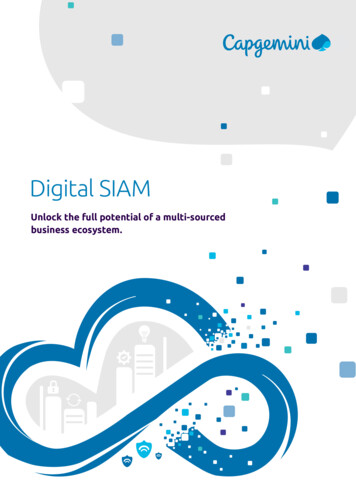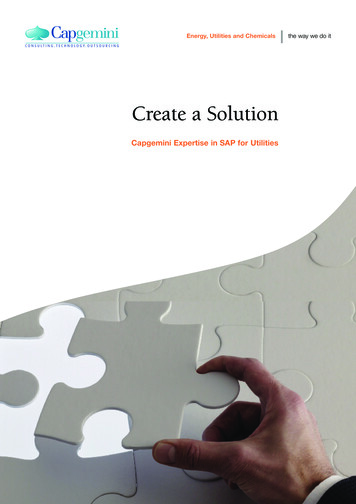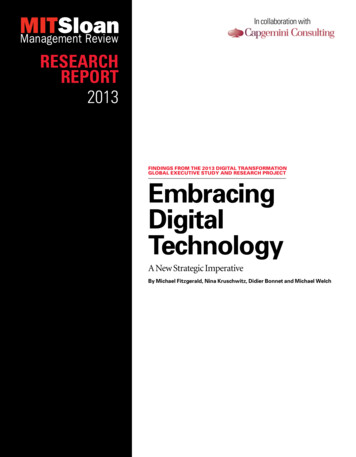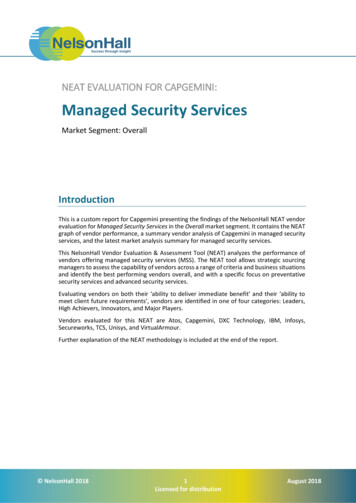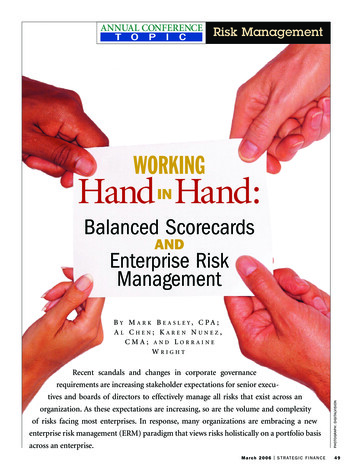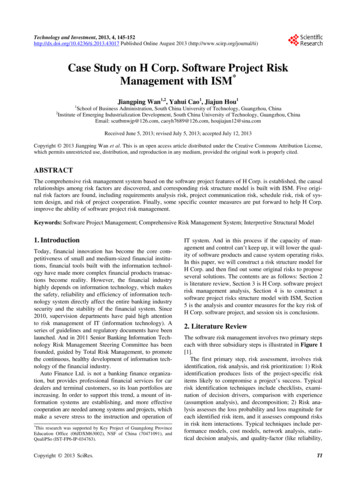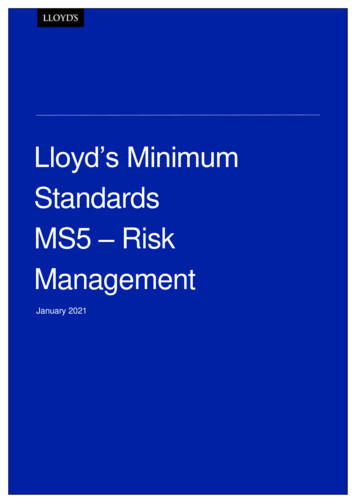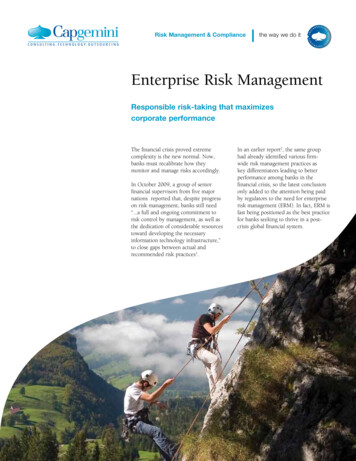
Transcription
Risk Management & Compliancethe way we do itEnterprise Risk ManagementResponsible risk-taking that maximizescorporate performanceThe financial crisis proved extremecomplexity is the new normal. Now,banks must recalibrate how theymonitor and manage risks accordingly.In October 2009, a group of seniorfinancial supervisors from five majornations reported that, despite progresson risk management, banks still need“.a full and ongoing commitment torisk control by management, as well asthe dedication of considerable resourcestoward developing the necessaryinformation technology infrastructure,”to close gaps between actual andrecommended risk practices1.In an earlier report2, the same grouphad already identified various firmwide risk management practices askey differentiators leading to betterperformance among banks in thefinancial crisis, so the latest conclusiononly added to the attention being paidby regulators to the need for enterpriserisk management (ERM). In fact, ERM isfast being positioned as the best practicefor banks seeking to thrive in a postcrisis global financial system.
ERM Practitioners Had an Edge in the CrisisEnterprise risk management practices were cited as a key differentiator by the SeniorSupervisors Group* in its 2008 report Observations on Risk Management Practices duringthe Recent Market Turbulence.Firms that “demonstrated a comprehensive approach to viewing firm-wide exposures andrisk, sharing quantitative and qualitative information more effectively across the firm andengaging in more effective dialogue across the management team” tended to deal moresuccessfully with the ongoing market turmoil (at least up to that point), said the group.More specifically, the Senior Supervisors Group said four firm-wide risk managementpractices differentiated better performance from worse among banks in the financial crisis.Those four practices are: Effective firm-wide risk identification and analysis, Consistent application of independent and rigorous valuation practices across the firm, Effective management of funding liquidity, capital, and the balance sheet, Informative and responsive risk measurement and management reporting.* The Senior Supervisors Group consists of 10 agencies representing 7 countries.U.S. Federal Reserve Board ChairmanBen S. Bernanke has publicly stated that“.policymakers must insist that thelarge financial firms they supervise becapable of monitoring and managingtheir risks in a timely manner and on anenterprise-wide basis.3”ERM is a Must Given the Evolutionof Financial Markets and RiskThe financial crisis demonstrated exactlyhow complex and interrelated riskshad become—and how ill-preparedmany banks were to monitor their ownexposures, especially across the firm.In the past, credit and market risk werecertainly less interrelated, with a crisisin one sector at times spilling overinto another but rarely underminingmultiple segments simultaneously. Themost recent financial crisis changedall that. Instead, the recent crisis wasmarked by the contagion effect amonginterdependent markets and players.Simple risk-diversification strategies oftendid little to mitigate losses, and certainproducts—such as derivatives like creditdefault swaps—relied on such a complexand interrelated web of counterpartiesthat all parties suffered when conditionschanged for underlying products.Given the changing shape of globalfinance, it is perhaps not surprising thatday-to-day risk-management practiceshave failed to keep pace. Unless yourbank takes to heart the lessons learnedfrom this financial crisis, it will be illprepared for the next.ERM can provide your bank with thecapabilities needed to:Accurately map and monitor thedifferent dimensions of risk andreturns across your entire organization Establish accountability for those risks/returns; and Institutionalize a risk appetite thatprovides your firm with a consistentprism through which to pursueprofitable and ‘opportunistic’ risks andavert hidden threats. 1Risk Management Lessons from the Global Banking Crisis of 2008, Senior Supervisors Group (SSG), October 21, 20092Observations on Risk Management Practices during the Recent Market Turbulence, Senior Supervisors Group, March 6, 20083Financial Reform to Address Systemic Risk, Ben S. Bernanke, Speech to the Council on Foreign Relations, March 10, 2009
Risk Management & ComplianceYour bank needs a degree of risk insightthat can only be achieved via ERM tooperate profitably in today’s complexglobal markets. In fact, without ERM,it will be increasingly difficult for yourbank to retain a competitive edge,return value to shareholders, or adaptto shifting demands around high-profileissues like compensation practices.Addressing Today’s RiskImperativesIn the face of the market and regulatoryrealities, the case for ERM seemsoverwhelming, but the evolving risklandscape has clearly created enormouschallenges for Chief Financial Officers(CFOs) and Chief Risk Officers(CROs) who must manage the actualimplementation of new risk systems orrecalibrate existing ones.There are numerous strategic issueskeeping bank CFOs and CROs awake atnight, but underlying almost all of thoseconcerns lies fundamental challengesin addressing issues of informationtransparency and data strategy.Regardless of whether your bank has anenterprise risk system in place, you stillneed to:the way we do itAchieve greater transparency, whichrequires a foundation of enterprise riskinformation; Elevate risk-data governance to astrategic business objective; Institutionalize integrated, reliablerisk applications at all levels ofmanagement. These three initiatives form criticalbuilding blocks in a sound ERMapproach. Without them any ERMapproach would be hard-pressedto either mitigate risk or maximizeopportunity in today’s complexoperating environment.With a robust, integrated data strategy,your bank will be better positionedto establish an enterprise view ofrisks so you can view, and activelymonitor, exposures across businesses,counterparties and risk dimensions. Thispicture lets your bank extract maximumvalue from each of the risks you takeon, identify the degree to which any riskexposure needs to be actively managed,and spot concentrations and otherhigh-risk exposures that exist or couldemerge as circumstances change.6 Key Data-Related Risk ChallengesAmong the top data-related challenges for many banks:1.Data is trapped in silos, e.g., after M&A, hiding firm-wide risk accumulations (andpotential portfolio off-sets).2.Inconsistent valuations and reference data exist across different parts of the firm.3.Few standards have been established for data (e.g., Are there clearly defineddefinitions/standards for risks/risk types?)4.Data-governance models are often inadequate (e.g., Who owns data and updates?Who verifies data? What policies ensure adherence to protocols?)5.Risk systems do not allow for proper analysis of firm-wide exposure across riskdimensions, counterparties, etc.6.Models generate incorrect forecasting of potential outcomes (e.g., models are toobackward-looking and not dynamic enough).
Capgemini’s Solutions to AddressRisk & Market ChallengesCapgemini offers solutions for EnterpriseRisk Management that give your bankthe tools and frameworks you needto optimize your risk managementcapabilities and integrate riskmanagement framework into strategicdecision-making processes.Our risk management offerings focuson developing a more integrated,transparent and predictable riskframework. Capgemini’s EnterpriseRisk Framework is highly flexibleand outlines a set of risk managementpractices that can be fully adoptedor adapted to your existing riskframework. Capgemini’s solutions canbe implemented as individual modulesor an end-to-end package to:Assess and analyze your firm’s existingEnterprise Risk Model; Develop your Enterprise RiskManagement Strategy covering keyareas such as loss forecasting, creditrisk scoring models and referencedata & semantics; Identify and support InformationStrategy & Architecture, Governance& Metadata, Customer DataIntegration and Master DataManagement; Build custom-tailored ERMDashboards and Reporting solutionsfor a holistic and comprehensive viewof risk exposures, including marketrisk models and methodologies andintegrated forecasting; Perform software selection,implementation and applicationsupport for Enterprise RiskManagement package solutionsfeaturing vendor partnerships withIBM, SAS, Oracle, Fermat, SunGard,Oracle and FinArch. Capgemini also understands thatespecially during tough times, financialservices organizations need quick returnswith minimal investment. Based onour experience with large global banks,Capgemini developed two highly focusedsolutions for enterprise risk managementthat bring quick benefits while alsohelping banks establish a roadmap fora longer-term ERM program.
Risk Management & ComplianceEnterprise Risk MaturityAssessment: Learn WhereYou StandWith our proprietary MaturityAssessment model, Capgemini can helpyou assess and analyze your bank’scurrent risk frameworks, includingthose for credit and operational risk.The assessment provides your firmwith an understanding of where youstand compared with industry bestpractices, regulatory standards andrecommendations, and gauges thedegree to which your existing datainfrastructures are adequate and scalableenough for future ERM needs.Capgemini’s Sigma Map lets you map risk types to the balance sheetAssetsBalance iskLiquidityRiskReputationRiskLoans &LeasesSecuritiesLiabilitiesDepositsGovt. Funds& ReposBorrowingsSubordinateNotesEquityAt the end of our assessment, Capgeminiwill deliver:An assessment of models for credit,market and operational risk; An evaluation of your Basel IIpreparedness, IT architecture andorganizational structure as it relatesto risk; A future-state roadmap for enterpriserisk management.the way we do itEconomic Capital Measures Enterprise Risk Dashboard: Seethe Whole PictureFor effective enterprise riskmanagement, your bank needs aclear understanding of the completerisk exposure and the impact of yourexposure on stock price valuations.Capgemini’s proprietary Sigma Map framework lets your bank capture anenterprise-wide view of risk positionsacross critical business dimensions soyou can proactively manage and controlthe entire risk profile. Through SigmaMap , we can help you map thebalance sheet to risk types and measurethe combined impact on stock price.Capgemini can help your firm developan enterprise risk dashboard that:Presents a holistic view of all risk typesfaced by your organization; Defines the risk/return trade-offs usingbest-in-class Key Risk Indicators; Integrates reference and market databenchmark performance; Lets you review changes in exposuresand evaluate the potential impact oncapital allocation; Provides a wealth of different reports; Supports loss forecasting and scenario& trend analysis. Using our real-world experienceimplementing risk managementdashboards for top 10 banks in theUS and across the globe, Capgemini’sERD is built on a proprietary PortfolioReporting Framework that leveragesour extensive experience. We can helpyour bank implement dashboards usingyour own data in a Capgemini-hostedenvironment or entirely within yourown infrastructure.
What Makes Capgemini Different?Capgemini is a proven and trustedpartner for providing enterprise riskmanagement and compliance solutionsand is currently assisting many of theworld’s large banking organizations intheir ERM initiatives. Here are few ofthe reasons Capgemini is preferred byour clients.exposure to the balance sheet. We fullyintegrate different risk componentsinto one enterprise view with our ERMDashboard and have developed a provenrisk- specific data mart which is basedon risk management principles andcritical factors most relevant for riskofficers and Boards of Directors.Highly Qualified Risk ProfessionalsWe have a highly experienced andcertified network of over 400 riskprofessionals who have executed morethan 100 Basel projects and 500 risk andcompliance projects in the last two years.Quick Wins to Support YourRisk InitiativesOur approach to ERM helps yourbank gain substantial benefits withminimal investment. Projects like ERMAssessments and Dashboards resultin measurable benefits in a very shorttimeframe and can help you builda business case for long-term ERMinitiatives. Benefits include:Capgemini’s risk professionals haveyears of experience developing creditrisk models and profiles, implementingBasel II standards, estimating the riskparameters for capital calculations,and maintaining economic capitalmodels, including Moody’s, PMand RAROC tools.Sigma Map and ERM MaturityFrameworkCapgemini’s expertise in riskmanagement is substantiated throughour proven ERM Maturity Frameworkand Sigma Map methodologywhich helps you match your risk Financial benefits. Our ERM insightshelp your whole organization bettercorrelate corporate performance torisk exposure, improve decisions oninvestment and capital allocation, andidentify risk opportunities that couldbe used for competitive advantage.Operational benefits: Since ERMprovides an effective framework forlinking strategic goals to operationalplans, Capgemini can help optimizeyour operations around a consistentUnparalleled risk knowledge & expertise Unmatched IP with over 74 risk and compliance assets including proprietary tools andmethodologies spanning all critical risk dimensionsProprietary methodology and tools for stress testing, loss forecasting, economic capital,risk scorecards, RAROC proprietary algorithms and risk data martsPre-fabricated ETL codes to pull data from key loan origination systems for acceleratedimplementations In-house economic capital simulation engine Reusable regulatory capital calculator and regulatory spreadsheets True enterprise risk view with integrated forecasting
Risk Management & Complianceview of risk appetite and exposuresand offer a single vantage pointthrough which risk appetite isdiscussed, communicated andintegrated firm-wide into business linesand decisions. Shareholder benefits. As your financesand operations improve, shareholdersand other stakeholders can gainconfidence from increased visibilityand transparency into your bank’s risk,possibly improving your bank’s abilityto compete for investor capital.Reduction in Compliance andRisk Management CostsCapgemini’s ERM solutions help yourbank reduce the operational costs youwould otherwise incur in maintainingredundant and disparate risk databases.the way we do itBy consolidating enterprise risk datain a single information system, yourbank can reduce overhead costs of datacollection by different business unitsor divisions. We leverage risk projectsfor assessing compliance preparedness,thereby reducing the cost of complianceprojects.Comprehensive Risk OfferingsCapgemini is one of the only riskmanagement consultancies offering fullend-to-end risk management services.Implemented independently or aspart of a Risk Management strategy,Capgemini’s highly flexible ERM andERD solutions help you achieve quickreturns while supporting your bank’slong-term ERM initiatives.Capgemini provides end-to-end support for Enterprise Risk Management initiativesRisk ManagementRegulatory ComplianceData ManagementAnalytic ServicesEnterprise Risk Management (ERM)Basel IIBusiness InformationStrategy, Architecture &AssessmentModeling Services ERM Assessment and Dashboard Compliance Assessment GRC Applications Support Training Compliance SupportCredit Risk (CR) CR Framework and Assessment CR Scoring Models and Reporting Mortgage Loss Forecasting Solvency II Market Risk (MR) Reference Data & Semantics Enterprise Models & Methodologies Analytics Models & Methods Information Strategy & Architecture Governance & Metadata Customer Data Integration & MasterDataSoftware Selection &IntegrationAwareness/Training Impact Analyses OR Assessment and Management Software Solutions Warehousing ReportingPredictive Modeling ModelValidation Loss Forecasting Profitability AnalysisStress TestingCompetitor BenchmarkingMetadata ManagementMaster Data ManagementFraud DetectionEconomic Capital (EC)Data Collection/Readiness Customer, Product EC FrameworkSoftware Selection &Integration Compliance, Risk Risk Adjusted Return On Capital InvestmentSEPA Impact Analyses Strategic Analysis Compliance SupportOperational Risk (OR) Information Management &Data Integration PSD Business ImpactAnalysisData Governance &StewardshipCompliance & Data Privacy Data Classification Data Cleansing
www.capgemini.com/financialservicesIn Practice: Capgemini’s has world class experience delivering ERM solutions for financial services firmsCollections ReportingSolution for a largeU.S. bankThe bank had disjointed Collections reporting and analysis capabilities populated using labor-intensive dailyprocesses. Capgemini provided a solution that served as the foundation for trending and analytical reportingincluding the preservation of history for year-over-year comparisons and economic cycle forecasting.Risk ManagementSolution for a globalbankOne of the largest banking and financial services organizations in the world was experiencing difficulties withthe risk reporting due to multiple sources of risk data which created problems in developing correct and on timecredit information. Capgemini developed a risk management solution to further develop, leverage and exceed peercompetencies and more fully develop Basel II relevant metrics, analysis and reports.Credit Risk DataMart for a large U.S.financial holdingcompanyThe financial holding company needed an integrated and centralized data management and reporting system toaddress redundant and conflicting loan information between reports, get consistent monthly snapshots of thestate of business and integrate data between sources. Capgemini built a single repository to perform credit riskmanagement analytics on the commercial and retail loan portfolios.Credit RiskMonitoring for one ofthe world’s largestfinancial firmsOur client needed to frequently monitor credit portfolios to provide pertinent information to senior management toinclude in the capital management process. Capgemini developed a Default Loss Data Repository (DLDR) of longterm history of default/loss experience to report, refine, calibrate PD and LGD estimates and delivered to an efficientframework for ad-hoc queries and analysis reporting.For more information, visitwww.capgemini.com/risk or emailriskandcompliance.fsgbu@capgemini.comAbout Capgemini and theCollaborative Business ExperienceCapgemini, one ofthe world’s foremostproviders of Consulting, Technologyand Outsourcing services, has a uniqueway of working with its clients, calledthe Collaborative Business Experience.focused methods and tools. Capgeminiutilizes a global delivery model calledRightshore which aims to offer theright resources in the right location atcompetitive cost, helping businessesthrive through the power of collaboration.Backed by over three decades of industryand service experience, the CollaborativeBusiness Experience is designed to helpour clients achieve better, faster, moresustainable results through seamlessaccess to our network of world-leadingtechnology partners and collaboration-Capgemini employs approximately92,000 people worldwide and reported2008 global revenues of 8.7 billion euros.More information about our services,offices and research is available atFS201001070628CSwww.capgemini.com.Copyright 2009 Capgemini. All rights reserved.
A future-state roadmap for enterprise risk management. Enterprise Risk Dashboard: See the Whole Picture For effective enterprise risk management, your bank needs a clear understanding of the complete risk exposure and the impact of your exposure on stock price valuations. Capgemini's proprietary Sigma Map framework lets your bank capture an
